Photography
KAMI NO MIYA
ISE JINGU – The 62nd Jingu Shikinen Sengu
The divine palace is newly constructed every twenty years
神の宮
伊勢神宮 第62回神宮式年遷宮
In October 2013, the “Orderly Transition ceremony (Sengyo-no-Ghi)” was held at “Nai-ku” and “Geku”, the inner and outer shrines of ISE JINGU, to transfer the subject of worshipped treasure to the main shrine, which is newly re-edificated. The inner shrine (Naiku)is called exactly “Kotaijingu”, and is the seat of a deity, “Amaterasu-Omikami’. She is the ancestral deity of the imperial family, as well as the total tutorship of Shintoism. The other, the outer shrine (Geku) is called “Toyoukedaijingu”, and is the seat of “Toyo’uke-no-Omikami”, who concerns all the food especially to offer to all the divinities. She is esteemed and worshipped as a guardian of the daily life and activities for industry.
This is the special habit to repeat the re-building Shrine itself, in case of Ise the supreme, every 20 years. In this occasion these are renewed not only the holy edifices of inner and outer shrines of Ise, but the offices of “Shin-en”, entrance gate (Torii) , Ujibashi Bridge. In addition, the sacred treasures and holy clothes prepared for the divinities (On-shozoku) are renewed, and pray for a “evergreen” of the world, i.e. eternal youth. Because of the routine of 20 years’ cycle of Sengu, traditional Japanese techniques will be preserved through the generation, as it was continued as ritual almost 1300 years already in the past. The idea of Sengu reveals eternity in the periodical re-generation which resonate with the current trend of a sustainable world.
It is the ancient Japanese idea that dwell all souls in all things - there are eight million gods originate from the worship of the Nature, and we wish to live mutual co-existence and co-prosperity with all thing. The ceremony that inherits and conveys that thought is exactly the ritual of Sengu. When Arnold J. Toynbee, the great British philosopher of history, visited ISE JINGU in 1967, reflected that “In this sacred place, I feel the Unity of which all religious minds consists.”
Every country and region has its own culture rooted in its climate. I hope that cruel conflicts will disappear with the effort to understand each other and respect each other, instead of judging by one side. In any case, animism, the root of the ancient Japanese cultural mind, scents all over the world especially before the development of modern scientific civilization. I hope that this tradition will continue to the future, to re-examine its essence for the sake of the earth and all life on it, and not abandon as a primitive religion.
-
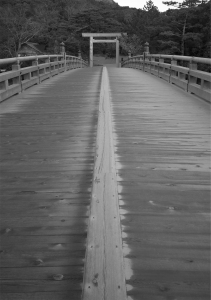
宇治橋
UjibashiUjibashi Bridge

宇治橋
UjibashiUjibashi Bridge
A bridge over the limpid Isuzugawa River. Ujibashi Bridge is said to be the boundary that connects the secular world to the sacred world, and worshippers cross this bridge to enter the sanctuary.
-

古殿地
KodenchiSite of the previous sanctuary
[Naiku]
古殿地
KodenchiSite of the previous sanctuary
[Naiku]The area where the new shrine will be built in this occasion. Until the ceremony to secure and calm the area, it is called the Kodenchi, but after that it becomes the Shin-mishikichi (New building site).
In ISE JINGU, a site will be set up next to the current main shrine and a new main shrine will be built here. The two areas alternately become Kodenchi and Shin-mishikichi, and this cycle has continued for 1,300 years.
-
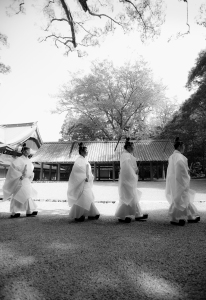
鎮地祭 参進
Chinchi-sai SansinA procession of Shinto priests heading to the Chinchi-sai ceremony
[Naiku] April 25, 2008
鎮地祭 参進
Chinchi-sai SansinA procession of Shinto priests heading to the Chinchi-sai ceremony
[Naiku] April 25, 2008Proceeding of Shinto priests towards the site to serve the Chinchi-sai. This ceremony is the first one held on the ground of the new shrine. Before starting the construction , they pray for the peace of the shrine grounds and the safety of construction to the deity sit in the main shrine area.
-

鎮地祭 二
Chinchi-sai 2Ceremony to secure and calm the area
[Naiku] April 25, 2008
鎮地祭 二
Chinchi-sai 2Ceremony to secure and calm the area
[Naiku] April 25, 2008Ritual ceremony of Chinci-sai by Shinto priests.
-

鎮地祭 二
Chinchi-sai 2Ceremony to secure and calm the area
[Geku] April 25, 2008
鎮地祭 二
Chinchi-sai 2Ceremony to secure and calm the area
[Geku] April 25, 2008Purification of Shinto priests before the ceremony. They must attend the ceremony in a state of being purified in mind and body. The Japanese habit of keeping things clean seems to have its roots in Shinto rituals.
-
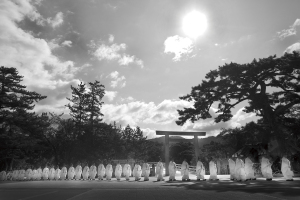
宇治橋渡始式
Ujibashi – watarihajime-shikiUjibashi Bridge opening ceremony
November 3, 2009
宇治橋渡始式
Ujibashi – watarihajime-shikiUjibashi Bridge opening ceremony
November 3, 2009About 100 million people cross the Ujibashi Bridge every 20 years. The Ujibashi Bridge Opening Ceremony is a ritual to praise the completion of the bridge and pray for its safety.
-
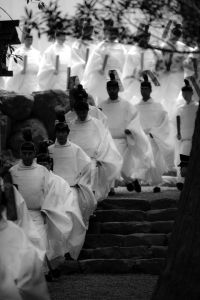
上棟祭 退下
Joto-sai TaigeShinto priests leaving the Joto-sai ceremony
[Naiku] March 26, 2012
上棟祭 退下
Joto-sai TaigeShinto priests leaving the Joto-sai ceremony
[Naiku] March 26, 2012Joto-sai is a ceremony held when the ridgepole of the new main shrine is raised. Here too, sacred food is offered and prayers are recited to Yafune-no-Okami, who is in this site, called Omiyadokoro.
This is the scene of the Shinto priests leaving the Naiku after this ritual ceremony. -
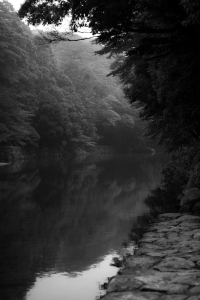
五十鈴川 御手洗場
Isuzugawa MitarashiSite for ablution at Isuzugawa River
[Naiku]
五十鈴川 御手洗場
Isuzugawa MitarashiSite for ablution at Isuzugawa River
[Naiku]The Isuzugawa River, which flows through Naiku, quickly returns to its limpid stream, even if the water becomes muddy after a night rain. First, pilgrims purify their hands at this river and clear their minds before visiting. A custom that has been traditionally practiced since ancient times.
-
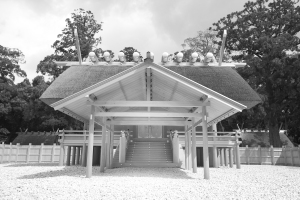
新宮 一
Ni-miya 1New Shrine
[Geku], September 4, 2013
新宮 一
Ni-miya 1New Shrine
[Geku], September 4, 2013On October 5th, the enshrined deity, Toyo’uke-no-Omikami, will be transferred here. Originally, this New Shrine of Geku was a sacred area and is strictly forbidden to enter or survey inside. It reflects the ancient style of Japanese architecture, and the custom of using raw hinoki-cypress timber evolved from a “granary” with floating floor to a “palace” style. The fact that the shape of the main shrine reflects the granary reminds us of the preciousness of rice.
-

新宮 三
Ni-miya 3New Shrine
[Geku], September 4, 2013
新宮 三
Ni-miya 3New Shrine
[Geku], September 4, 2013On October 5th, the enshrined deity, Toyouke-O-mikami, will be transferred here. Originally, this New Shrine of Ge-ku was a sacred area and is strictly forbidden to enter or survey inside.
-
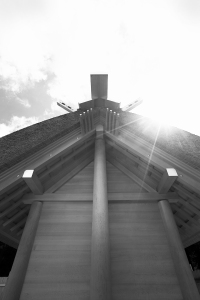
新宮 六
Ni-miya 6New Shrine
[Geku], September 4, 2013
新宮 六
Ni-miya 6New Shrine
[Geku], September 4, 2013Side view of the New Shrine. A tough ridge pillar sustains the gable. There is a " Shin-no-mihashira", pivotal foundation pillar under the floor of this structure, and it is said that a deity resides there.
-

新宮 一
Ni-miya 1New Shrine
[Naiku], September 4, 2013
新宮 一
Ni-miya 1New Shrine
[Naiku], September 4, 2013On October 2nd, the adored deity Amaterasu-Omikami will be transferred to Ni-miya.
This New Shrine is constructed in an ancient style of Japanese architecture called “Yuiitsu-Shinmei-zukuri”. Once every 20 years, not only the shrine structures and torii-gate in the sanctuary garden but the Ujibashi Bridge are completely rebuilt. Naturally, required a huge amount of materials to accomplish them. So there planted Hinoki-cypress trees within the territory of Ise Jingu for the purpose of relocating the shrine 200 years later since Taisho-period. In addition, the scrap materials from the old shrine buildings are used for the repair of shrines scattered throughout the country and the reconstruction of shrines that have suffered disasters. Every old material is originally a gift from nature and is never wasted. The spirit of living in harmony with nature and of cherishing things are transmitted through the tradition of Sengu. -
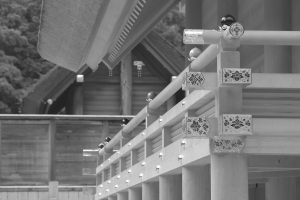
新宮 三
Ni-miya 3New Shrine
[Naiku], September 4, 2013
新宮 三
Ni-miya 3New Shrine
[Naiku], September 4, 2013The balustrade of Ni-miya is delicately and beautifully crafted, and the craftsmanship that connects tradition is recognized in all details.
In the background is the Main Shrine before the Sengu ritual. At Ise Jingu, the site is set up next to the Main Shrine, and a New Main Shrine is built here. The two sites alternately become the old site and the new site. This cycle has continued for 1,300 years. For a while after the new shrine is completed and the subject of worship is transferred, the identical two sacred constructions can be seen side by side from the sky. This must be a fleeting and admirable sight! -

抜穂祭 二
Nuibo-sai 2Rice harvesting ceremony
September 5, 2013
抜穂祭 二
Nuibo-sai 2Rice harvesting ceremony
September 5, 2013The Nuibo-sai is a ceremony to reap the rice for the first time of the year at the sacred paddy fields of Ise Jingu. This is the opening ceremony to Kanname-sai (feast with divinity), which is an important ritual of Ise Jingu, and is held according to the ancient behavior to express gratitude for blessings.
-
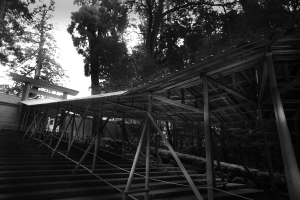
雨儀廊
UghiroCorridor against the rain
[Naiku]
雨儀廊
UghiroCorridor against the rain
[Naiku]This corridor Ugiro, which connects the main shrine to the new one, is especially designed to prevent the subject of worship from getting wet in the rain during the transfer. As soon as the transfer is over, it should be removed, so it is an unusual spectacle.
-
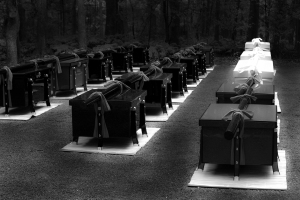
川原大祓 一
Kawara-Oharai 1Grand Purificaton at Kawara
[Naiku] October 1, 2013
川原大祓 一
Kawara-Oharai 1Grand Purificaton at Kawara
[Naiku] October 1, 2013On October 1, the day before the transfer, the grand purification ceremony was held at a designated place in the Inner Shrine to purify all the sacred treasures to be settled in the New Main Shrine and the Shinto priests who would perform the ceremony. All of the dedicatory costumes and sacred treasures are stored in plain wood or vermillion lacquered chests.
There are 540 sacred treasures in the Inner Shrine. The essence of Japanese craftsmanship is concentrated there. In the “Shikinen-Sengu”, which takes place once every 20 years, these precious arts will get the successors. -
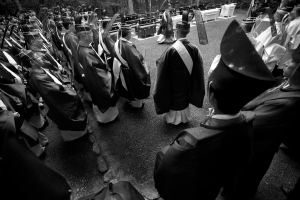
川原大祓 二
Kawara-Oharai 2Grand Purificaton at Kawara
[Naiku] October 1, 2013
川原大祓 二
Kawara-Oharai 2Grand Purificaton at Kawara
[Naiku] October 1, 2013All who concern the ritual of Sengu, include Atsuko Ikeda, the Master of this ceremony, Dai-guji, Sho-guji, and all other Shinto priests, gathered at “Kawara Oharai” in the Inner Shrine. They are all dressed in ceremonial attire for the day of the Sengu. Traditional costumes are very difficult to wear well. The art of beautifully wearing the “Kowa Shozoku”, which was devised as a dignified costume in the late Heian period, is called "Emon-do", and this special manner has been conserved mainly by the ex-nobles.
-
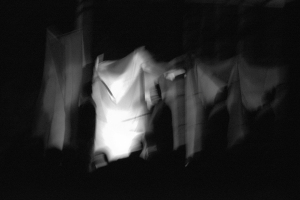
遷御の儀 一
Sengyo-no-Ghi 1Ritual of Transfer
[Naiku] October 2, 2013
遷御の儀 一
Sengyo-no-Ghi 1Ritual of Transfer
[Naiku] October 2, 2013Before 8:00 p.m. of the day, in the precincts of pure darkness where all the torches have been extinguished, the rooster crowing, “KA-KE-KO-U” resounds three times from the mouth of a Shinto priest. This is based on the legendary myth of “Amano-iwato-biraki”. After the simulation of the rooster crowing, the imperial messenger declares “departure'' three times from downstairs. At exactly 8:00 p.m., the subject of worship is carried by the Daiguji, Shoguji, and Neghi. It is carefully hidden behind the pure white silk shielding and a fence-like enclosure also made of silk cloth during this procession, and solemnly transferred from the Main Shrine to the new one.
-
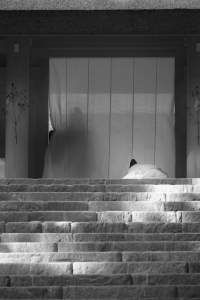
古物渡 二
Komotsu-watashi 2Movement of sacred treasures
[Naiku] October 3, 2013
古物渡 二
Komotsu-watashi 2Movement of sacred treasures
[Naiku] October 3, 2013Since the subject of worship was moved to the new shrine, this became the Main Shrine, and the ex-Main Shrine is now called “Koden”(the Old Shrine) . The transfer of the sacred treasures in the Old Shrine to the “Saiho-den” in the new Main Shrine is called “Komotsu-watashi”.
-

御神楽 御饌
Mikagura MikeHoly dance with music dedicated to the throne of the deity ,Offering Dishes
[Naiku] October 3, 2013
御神楽 御饌
Mikagura MikeHoly dance with music dedicated to the throne of the deity ,Offering Dishes
[Naiku] October 3, 2013Before the “Mikagura” (Holy dance with music celebration), which is dedicated for the first time on the day after the Ritual of Transfer “Sengyo-no-ghi”, a divine offering dish “O-mike”is dedicated as a sacrifice to the altar. Before the offering, the priests who play a role should be purified with the “Sakaki”(green branches of Japanese cleyera ) in front of the “Imibi-ya-den”.
-
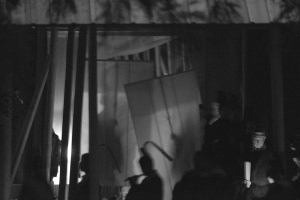
遷御の儀 一
Sengyo-no-Ghi 1Ritual of Transfer
[Geku], October 5, 2013
遷御の儀 一
Sengyo-no-Ghi 1Ritual of Transfer
[Geku], October 5, 2013On this day at 8:00 p.m, the Shinto priest resounds three times, the rooster crowing, "KA-KE-RO-O," which is different from "KA-KE-KO-U" at the inner shrine, and the Ritual of transfer begins. Second the legendary myth of “Amano-iwato-biraki”, The rooster crowed and prayed for Amaterasu-Omikami to come out of the cave (Amano-iwato) in which she hid herself, and announcing her appearance to the world. And it is said that a peaceful world full of light won over the world of darkness.
After the rooster crowing, the imperial messenger declares “departure (shutsu-gyo)'' three times from downstairs. In the darkness, the subject of worship is solemnly transferred with a fence-like enclosure (kingai). -
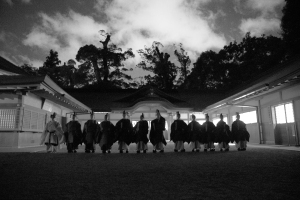
御神楽 一
Mikagura 1Holy dance ceremony
[Geku] , October 6, 2013
御神楽 一
Mikagura 1Holy dance ceremony
[Geku] , October 6, 2013Musicians from the Imperial Court were sent by the Emperor to dedicate Holy dance (Mikagura) and secret music. The celebratory “Mikagura” continues until midnight, and this ceremony concludes the official events of the “62nd Jingu Shikinen-Sengu”.
-

御神楽 三
Mikagura 3Holy dance ceremony
[Geku] , October 6, 2013
御神楽 三
Mikagura 3Holy dance ceremony
[Geku] , October 6, 2013At 7:00 p.m., the day after the Ritual of transfer, the ceremony of “Mikagura” was held at Geku to offer traditional Japanese court music (Gagaku). An imperial messenger sent by the Emperor and Ms. Sayako Kuroda, the special host of the temporary ceremony, also attended to celebrate the completion of the Ritual. In the precincts of pure darkness, only the fire of the torch illuminates the feet of the Shinto priests who attend “Mikagura”.
-
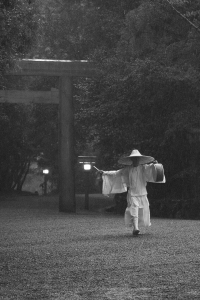
神嘗祭 御卜 参進太鼓
Kanname-sai Miura Sanshin-daikoKanname-sai ceremony, Augury in front of the Kami, Arrival announcement drum
[Naiku], October 15, 2013
神嘗祭 御卜 参進太鼓
Kanname-sai Miura Sanshin-daikoKanname-sai ceremony, Augury in front of the Kami, Arrival announcement drum
[Naiku], October 15, 2013On the evening of late autumn, the drums are thundered to herald the arrival of the Shinto priests who serve the “Kanname-sai”. “Mi-ura” is an augury to ask whether the Shinto priest who serves the ceremony is suitable for the divine intention.
-
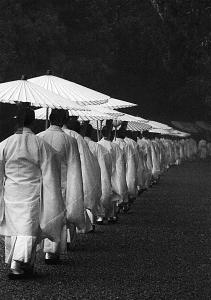
神嘗祭 御卜 参進 一
Kanname-sai Miura Sanshin 1Kanname-sai ceremony , Augury in front of the Kami, Procession
[Naiku], October 15, 2013
神嘗祭 御卜 参進 一
Kanname-sai Miura Sanshin 1Kanname-sai ceremony , Augury in front of the Kami, Procession
[Naiku], October 15, 2013A procession of priests marching to receive augury of Kami. A sense of reverence for the divinities permeates through the quiet and ordered procession under the rain.
Ise-Jingu holds more than 1,500 ceremonies a year, but there are three Rituals which have the main importance, “Tsukinami-sai” in June and December, and “Kanname-sai” in October. In particular, “Shikinen-Sengu” is also known as the Great “O-Kanname-sai”. -
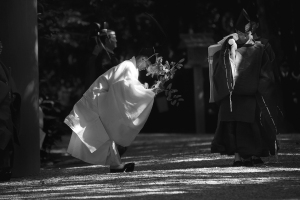
神嘗祭 奉幣
Kanname-sai HouheiKanname-sai ceremony, Ritual Dedication of “Heihaku”
[Geku], October 16, 2013
神嘗祭 奉幣
Kanname-sai HouheiKanname-sai ceremony, Ritual Dedication of “Heihaku”
[Geku], October 16, 2013An imperial messenger visits “Toyo’uke-no-Omikami”, the enshrined deity of the Outer Shrine, and a “Heihaku” is dedicated. “Heihaku” refers to five-colored silk and several kinds of textiles, and has inherited the tradition of offering silk fabrics as the most valuable offerings in an era when there were no minted coins.
-
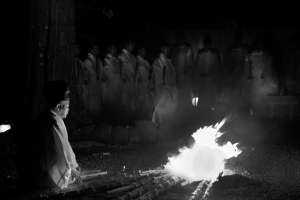
神嘗祭 由貴夕大御饌 二
Kanname-sai Yuki-no-Yube-no-Omike 2The Ritual of banquet at Kanname-sai ceremony
[Naiku], October 16, 2013
神嘗祭 由貴夕大御饌 二
Kanname-sai Yuki-no-Yube-no-Omike 2The Ritual of banquet at Kanname-sai ceremony
[Naiku], October 16, 2013Before 10:00 p.m., there placed the Offering Dishes (Mike) putted in “Kara-hiitsu”, in front of the “Imibiya-den” next to the “Kagura-den”. After the ritual purification, “Mike” is carried to the Main Shrine and other separate shrines within the “Shin-en” area. In occasion of the “Yuki-no-Omike” of the Kanname-sai ceremony, about 30 items are offered to the altar, including the year's new crops, dried abalone, lobster, etc. Along with gratitude for the blessings of nature as the blessings of divinities, prayed for the prosperity of the imperial family, national security, fertile harvests, and peace for the people. It is said that Shinto priests and people in this region never eat freshly harvested rice until the celebration of Kanname-sai ceremony, and this is another example of ancient Japanese traditional spirituality.
Click on the photo to see the individual portfolios.
